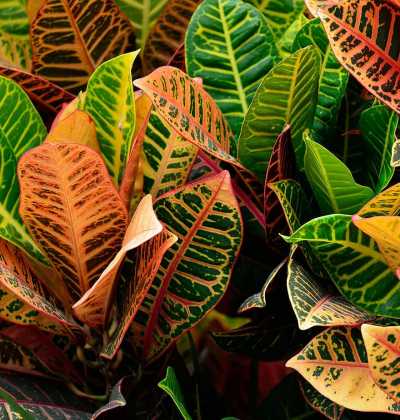Growing houseplants with the utmost care is one of the most amazing feelings for garden lovers. Croton plant is a popular houseplant and is preferred by many, primarily due to the forgiving nature of the plant. If you observe closely, the croton plants don’t usually demand strict requirements, but if not taken seriously, they can start to show signs of resentment.
One way of telling how your negligence is affecting the plants is croton leaves dropping. This is not a healthy sign, and once observed, it should be taken seriously. In the preceding article, we will look at which of the habits are contributing to drooping leaves of the croton plants and some tips reflecting on how to fix these causes.
Why My Croton Dropping Leaves?

Here are some of the most probable reasons for why you witness your croton houseplants drop leaves. It is important to note that the causes for dropping leaves are not confined to what is mentioned below, and there may be additional non-common features. However, if you take maximum precautions, your plant will restore its health and lush green texture.
Further, we have some quick solutions for each of your croton plant problems. Follow through the below mentioned causes and tips on how to fix them tips to revive your plant.
Also Read: Holes in Peace Lily Leaves: Why and What Causes
Right Container
The container in which your croton plant is placed serves as a home for your plant for most part of the time. Choosing the right size, material, and shape of container is very important to ensure that your plant grows to it
ontainer that is significantly smaller than the overall size of your plant, it can cause the roots to be soggy, wet, and rotten. In addition, it also restricts the drainage quality of your container. Not to mention, dropping of croton leaves can be a good proof for this.
If you cannot find a container of an appropriate size, use gravels and a potting mixture that absorbs excess moisture to keep the plant fresh.
Soil Conditions
Soil provides an adequate breathing space to your plants. Hence, it is important that we select a potting mixture that is nutritive and has good drainage properties. If your soil does not dispense adequate nutrients and drainage qualities, it can reflect in your crotons dropping their leaves incessantly.
Well draining potting mix is commonly available commercially. If you have difficulty finding the most suitable mix for yourself, you can manage the drainage levels by adding vermiculite and perlite to your soil mixture. It would improve the moisture and drainage conditions of your soil.
Also Read: Why Is My Fiddle Leaf Dropping Leaves?
Meeting the light requirements
Surprisingly, when it comes to crotons, they react very specifically to their light requirements. They cannot survive in low or very bright light conditions and it does impact how they stand, look, and feel. If you want to give a suitable amount of light to your plant, make sure that it is available for at least 4 to 6 hours each day. Do not exceed the lim[it though, it can cause the leaves to drop off.
To meet the light requirements of your plants, it is important to know and decide where you are most likely to place your plant. Is it indoors or outdoors? If you plant your croton houseplant outside, always make a popper arrangement for moving it to shade as and when required.
Exposing your plant to bright direct sunlight is never a good option. Partial light is what your plants require. On the other hand, if you opt to increase the beauty of your indoor setting by placing the plant indoors, the most suitable position is in front of an east or west-facing window.
Also Read: Why Do My Money Plant Leaves Turn Yellow?
Temperature
Crotons find it hard to tolerate sudden temperature changes and they are very particular about the temperature range in which they are placed. If you live in moderate conditions, you will not notice any difficulties with temperature ranges. However, it is challenging for people living in extreme weather conditions to give proper care to crotons.
The ideal temperature range for your croton plants to thrive is between 15-29 degree celsius. However, as mentioned earlier, they are not very specific in their expectations, which is why the ideal temperature range covered is huge.
Anything below 10 degrees Celsius and above 35 degree celsius is a hazard for your plant health. You can use various methods to regulate the temperature requirements of your plant. Extremely hot and cold environments can be fatal for your plant.
Additional temperature regulation tips include moving the plant away from cooling/heating vents, uninsulated windows, entrance doors, and heat registers.
Humidity
Croton pants prefer to survive in humid environments and low humidity can cause their leaves to droop down immediately. This can also be made evident from the fact that they are natives of the Southeast Asian rainforests, which are known for their intense humid conditions.
Crotons expect you to replicate the same conditions. If you fail to do so, they display their resentment by shedding and dropping their leaves. Unfortunately, this is not a healthy sign for your houseplant.
The ideal humidity range for croton plants is 70% but considering the flexible nature of the plant, it can survive in conditions that go as low as 40% and still support humidity.
If the situation is grave and you find yourself at a loss of solutions, then investing in a good quality humidifier seems to be the best decision, one that you won’t regret.
Also Read: How to Revive Dying String of Pearls?
Watering needs
Ensuring that your plants get adequate water involves both overwatering and underwatering of the plant. Either of the situations can result in bad influences on your plant, and it is not limited to croton houseplants.
If you are underwatering your plants and are not able to identify it, reach out for the soil. If the texture is dry, arid, and cranky, that means the plant is essentially devoid of water.
The good news is that it is not difficult to fix this issue. You just have to opt for a proper water soaking method and fix the issue. Make sure to follow a regular schedule for catering your croton plants, till they revive their moisture levels.
In case of overwatering, you will have to evaluate the damage that is done to our plant. Idf you feel that the roots are fine and just wet, simply stopping watering for a few days will resolve the issue. However, if root rot has already happened, you’d have to shift to safe and careful repotting measures as soon as you detect it.
Apart from the quantity of water that your plants get, it is also important to analyse the quality of water it receives. Most people neglect this point, but this is as important as anything else.
Most of us rely on tap water to feed the plants, but do you ever inspect the quality?
Research shows that bad quality water can promote unhealthy growth and development patterns in plants, and it is definitely true. One should install a proper and safe water filter that makes sure no harmful chemicals are making their way to the plant through the water.
Using fertilizers
It is a known fact that fertilizers act like food for plants. But there is a limit to how much food we can eat, right? Same goes for plants. They cannot bear excessive amounts of fertilizers and it can even impact their Health in the fertilizing agents can cause root toxicity which can lead your plant to death.
The ideal amount for applying fertilizers varies from one plant to another. However, you can start by applying them once every month and not more than that. Observe how they are reacting to such conditions and then continue as needed.
Additional tips
As you know the croton plant does not support sudden changes, you should wait out before introducing new environments to the plant. Nothing really much that you can do.
Since your croton plants can be a home to pests like spider mites, you can use an ingredient as simple as water to wash off these termites from the plant and cleanse them with a cotton swab dipped in alcohol for best result. In cases of non-availability of alcohol, you can also use neem oil.
If you find that your plants are infected with diseases that could be fatal to the health of the plant, which they usually are, then you should immediately isolate them from other plants and keep them under sunlight for a few days, until the infection weras of and the plant is safe. In addition, don’t forget to take care of them as you usually do on normal days. They need it now more than ever.
Conclusion
If you are worried about your croton plants dropping leaves, following the aforementioned causes and tips would be beneficial and would ensure that the health of your plants is restored as quickly as possible.
For getting regular care tips about your croton plants, read our related articles!
